 |
 |
 |
| |
HALT-C Study Design Flawed
|
| |
| |
Reported by Jules Levin
43rd EASL Conference, April 23-27, 2008, Milan, Italy
It's a good thing I return home Monday so I can tighten up my glucose control/management since I've overindulged myself here with chocolates, ice cream, and pizza.
from Jules Levin: There were 2 oral talks of note at this morning's final session at EASL. The subject of this oral presentation by Mitch Shiffman was regarding the effect of viral suppression on clinical outcomes in the HALT-C Study. They found that viral suppression was associated with clinical outcomes. We all know that at AASLD the HALT-C team announced that there was no benefit found in this study for maintenance therapy, in terms of the clinical outcomes examined in this study. However, today it was presented that a 4-log viral load suppression may be associated with improved clinical outcomes. Shiffman reported there was a trend towards a benefit regarding clinical outcomes for patients who achieved a 4-log viral suppression during maintenance therapy. But the number of patients was small, 35 patients managed to achieve a 4 log viral load reduction so the finding is not clinically significant. The important point is that for patients who achieve a certain level of viral suppression there may be a benefit from maintenance therapy, but the HALT-C investigators announced at AASLD flatly there is no benefit, but then they report this analysis here at EASL. I went to the microphone and pointed this out to Shiffman after his talk and he pretty much dismissed my comments by merely repeating that their overall study findings were no benefit regarding clinical outcomes from maintenance therapy. However, after I spoke at the microphone Jean-Michel Pawlotsky went to the microphone and said he agreed with my point and that Jules' point is correct—that there may be a benefit for these patients. It seems that the HALT-C Study was not designed to look for a benefit regarding clinical outcomes due to viral suppression. So they could not know for sure if some patients benefit. In fact they cannot know if patients who achieve a certain thrshold of viral load reduction do in fact have a clinical benefit. We know that a certain level of viral load reduction does reduce inflammation and perhaps slow fibrosis progression. Therefore, my point makes sense. This could be the reason so many prior studies found a clinical benefit due to maintenance therapy, before the HALT-C Study. But, the HALT-C Study was not designed to detect a clinical benefit from viral suppression. Therefore, the HALT-C Study cannot in my opinion declare they have proven maintenance therapy does not provide clinical benefit. In fact, the data suggest if you achieve a certain threshold of viral suppression you may in fact have clinical benefit. The HALT-C data suggests this and the study is flawed. In fact I mentioned at the microphone that perhaps a higher dose of pegasys during maintenance therapy such as 135 ug/ml or 180 ug/ml rather than the 90 ug/ml used in HALT-C may be more likely to provide viral suppression, and Shiffman dismissed my comment again. If you look at the "Slides Of Note" as I call them below, you'll see about 40% of patients who achieved a 4-log viral load reduction during the lead-in phase also achieved a 4-log reduction during the maintenance phase. Perhaps if they all received a higher dose more patients would have achieved a large viral load reduction. If the study was designed to detect clinical benefit as it correlated with levels of viral suppression these data below suggest benefit may have been found. Still, the potential side effects and toxicities that could occur during maintenance therapy may outweigh the potential benefits but we deserve a study that properly assesses these considerations and this question.
"Suppression of Serum HCV RNA Levels During Maintenance Peginterferon Alfa-2a Therapy and Clinical Outcomes in the HALT-C Trial"
ML Shiffman reported for the HALT-C team.
There was one box from this slide that does not appear in my picture because its appearance was delayed and it was in the uppermost righthand corner.
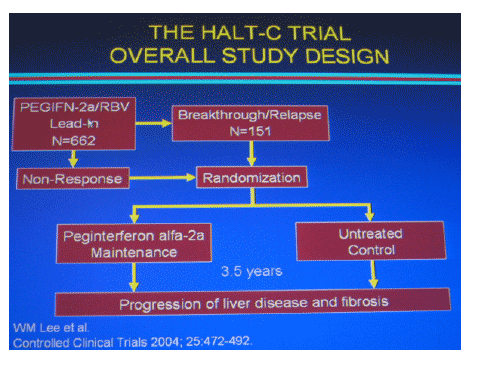
But as I said above the study was not designed to see if viral suppression during maintenance therapy reduced the clinical outcomes listed in this slide.

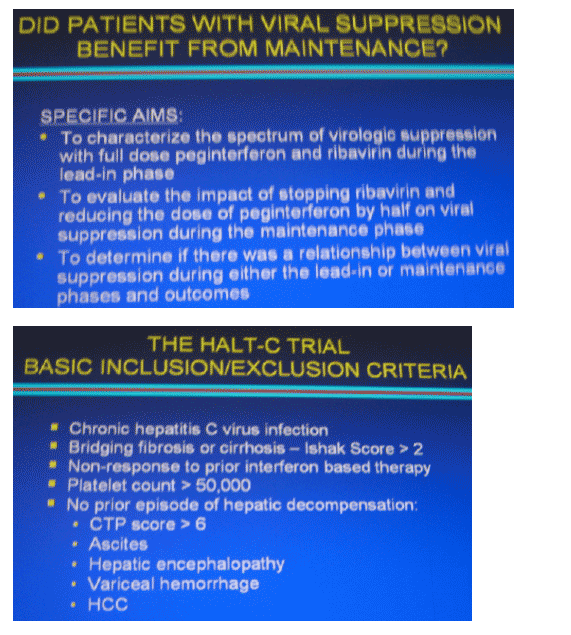
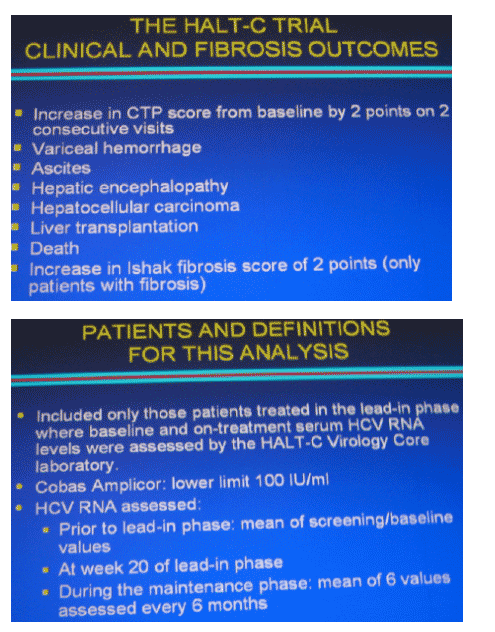
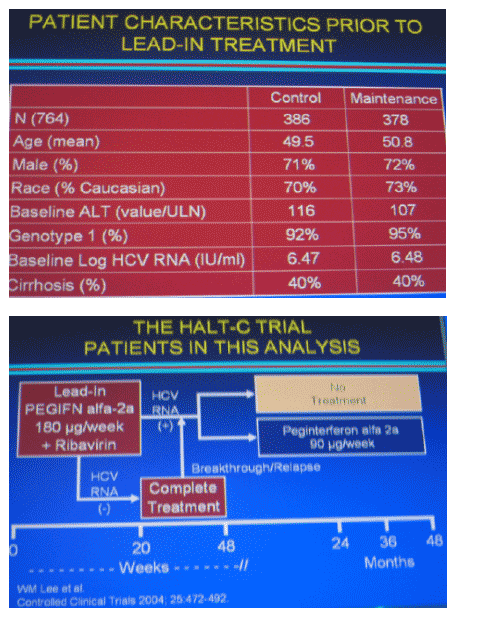
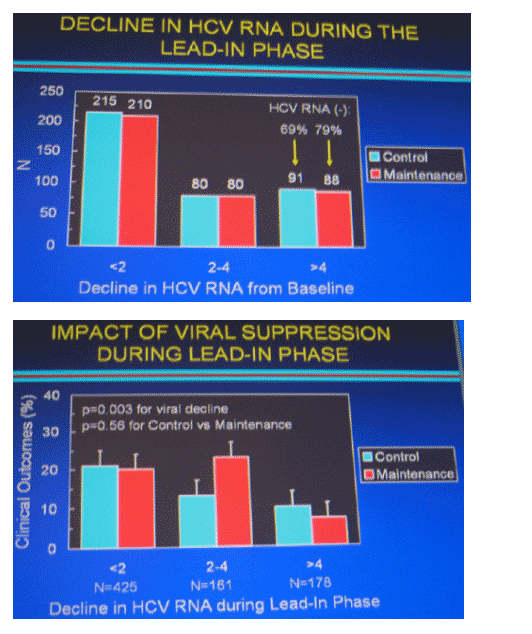

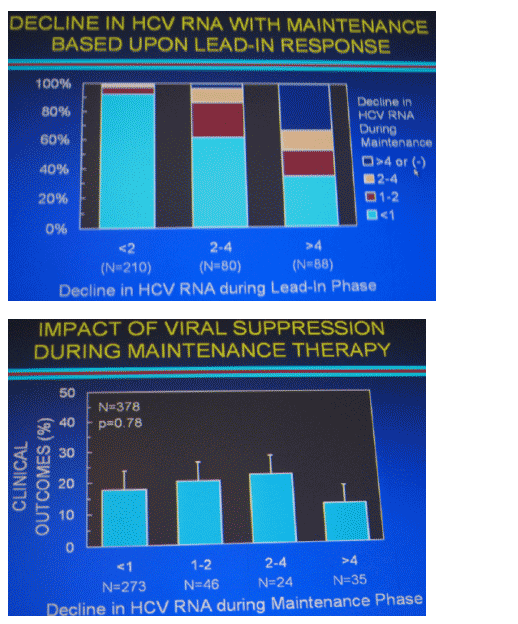
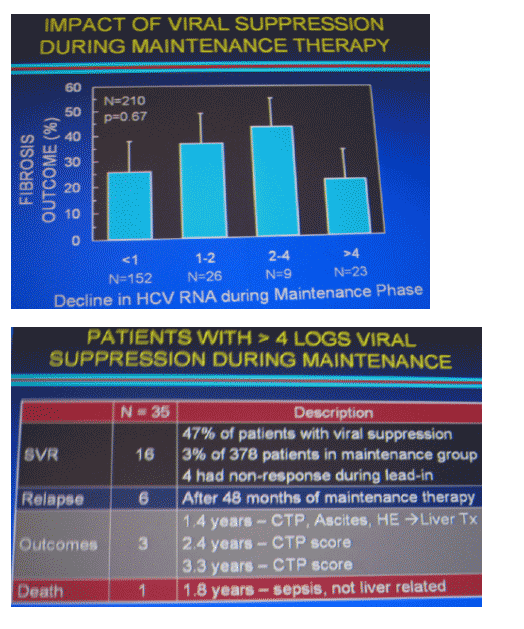
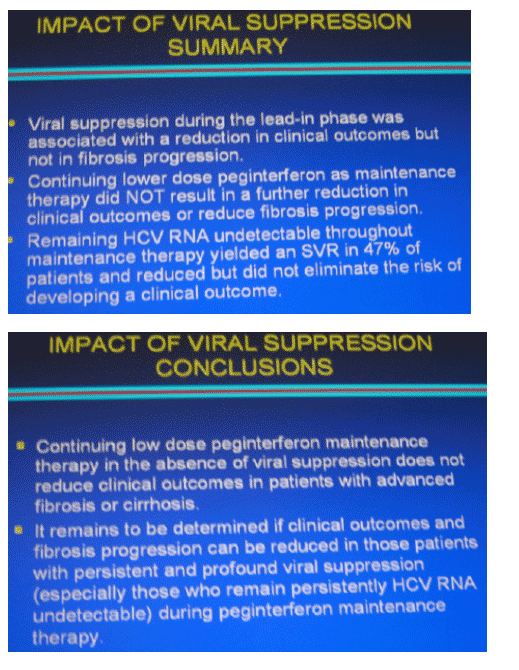
|
| |
|
 |
 |
|
|